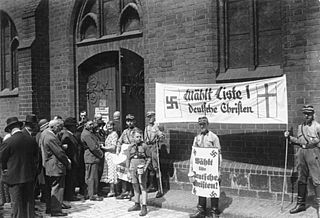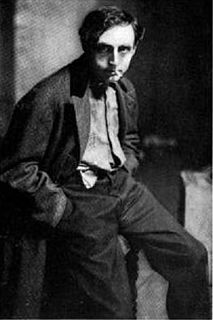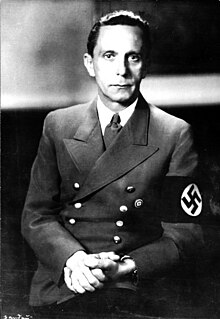Related Research Articles

Nazi Germany, officially known as the German Reich until 1943 and Greater German Reich in 1943–45, was the German state between 1933 and 1945, when Adolf Hitler and the Nazi Party controlled the country which they transformed into a dictatorship. Under Hitler's rule, Germany quickly became a totalitarian state where nearly all aspects of life were controlled by the government. The Third Reich, meaning "Third Realm" or "Third Empire", alluded to the Nazis' conceit that Nazi Germany was the successor to the earlier Holy Roman Empire (800–1806) and German Empire (1871–1918). The Third Reich, which Hitler and the Nazis referred to as the Thousand Year Reich, ended in May 1945 after just 12 years, when the Allies defeated Germany, ending World War II in Europe.

The Nuremberg Rally was the annual rally of the Nazi Party in Germany, held from 1923 to 1938. They were large Nazi propaganda events, especially after Adolf Hitler's rise to power in 1933. These events were held at the Nazi party rally grounds in Nuremberg from 1933 to 1938 and are usually referred to in English as the "Nuremberg Rallies". Many films were made to commemorate them, including Leni Riefenstahl's Triumph of the Will and The Victory of Faith.

During the Weimar Republic and the first years of the Third Reich from 1921 to 1935, the Reichswehr was the official name of the German armed forces, which were organized as a professional army at that time. After the German Army (Reichsheer) had been dissolved in January 1919 and was to be transformed into a peace army, the Reich government decided in March 1919 to form a provisional Reichswehr. Due to the conditions of the Versailles Treaty of 1919, the scope and armament of the Reichswehr were subject to severe restrictions. After the "regaining of military sovereignty" announced by Adolf Hitler in 1935, the Reichswehr was incorporated into the new Wehrmacht. The Reichswehr acted as a state within a state, and its leadership was an important political power factor within the Weimar Republic. The Reichswehr partly supported the democratic form of government, as in the Ebert-Groener Pact, and partly it supported anti-democratic forces with the Black Reichswehr. The Reichswehr saw itself as a cadre army, which should receive the expertise of the old imperial military and thus form the basis for rearmament.

The coat of arms of Germany displays a black eagle with a red beak, a red tongue and red feet on a golden field, which is blazoned: Or, an eagle displayed sable beaked langued and membered gules. This is the Bundesadler, formerly known as Reichsadler. It is one of the oldest coats of arms in the world, and today the oldest national symbol used in Europe.

The Hitler cabinet was the government of Nazi Germany between 30 January 1933 and 30 April 1945 upon the appointment of Adolf Hitler as Chancellor of the German Reich by president Paul von Hindenburg. It was originally contrived by the national conservative politician Franz von Papen, who reserved the office of the Vice-Chancellor for himself. Originally, Hitler's first cabinet was called the Reich Cabinet of National Salvation, which was a coalition of the Nazi Party (NSDAP) and the national conservative German National People's Party (DNVP); it became an exclusively Nazi cabinet when the DNVP was intimidated into dissolving itself.

The flag of Nazi Germany, officially the flag of the German Reich, featured a red flag with the swastika on a white disc. This flag came into use initially as the banner of the National Socialist German Workers' Party (NSDAP) after its foundation. Following the appointment of Adolf Hitler as Chancellor in 1933, the flag was adopted as the one of the nation's dual national flags, the other being the black-white-red horizontal tricolour of the German Empire.

The Reich Chancellery was the traditional name of the office of the Chancellor of Germany in the period of the German Reich from 1878 to 1945. The Chancellery's seat, selected and prepared since 1875, was the former city palace of Prince Antoni Radziwiłł (1775–1833) on Wilhelmstraße in Berlin. Both the palace and a new Reich Chancellery building were seriously damaged during World War II and subsequently demolished.

The German Evangelical Church was a successor to the German Evangelical Church Confederation from 1933 until 1945.

The Reich Labour Service was a major organisation established in Nazi Germany as an agency to help mitigate the effects of unemployment on the German economy, militarise the workforce and indoctrinate it with Nazi ideology. It was the official state labour service, divided into separate sections for men and women.

The Nuremberg Laws were antisemitic and racist laws that were enacted in Nazi Germany on 15 September 1935, at a special meeting of the Reichstag convened during the annual Nuremberg Rally of the Nazi Party. The two laws were the Law for the Protection of German Blood and German Honour, which forbade marriages and extramarital intercourse between Jews and Germans and the employment of German females under 45 in Jewish households, and the Reich Citizenship Law, which declared that only those of German or related blood were eligible to be Reich citizens. The remainder were classed as state subjects without any citizenship rights. A supplementary decree outlining the definition of who was Jewish was passed on 14 November, and the Reich Citizenship Law officially came into force on that date. The laws were expanded on 26 November 1935 to include Romani and Black people. This supplementary decree defined Romanis as "enemies of the race-based state", the same category as Jews.

Frank Reicher was a German-born American actor, director and producer. He is best known for playing Captain Englehorn in the 1933 film King Kong.

The Reich Ministry of Public Enlightenment and Propaganda, Ministry of Propaganda, was a Nazi government agency to enforce Nazi ideology.
Paranerita is a genus of moths in the family Erebidae erected by George Hampson in 1901.
The 1935 Tschammerpokal was the 1st season of the annual German football cup competition. This was the first time a national cup tournament was held in Germany. Its name was chosen in honour of Reichssportführer Hans von Tschammer und Osten, then the highest ranking sports official in the Third Reich. The tournament began on 6 January 1935 and ended on 8 December 1935. About 4,100 teams competed in the qualifying tournament which was divided into four stages. 63 teams competed in the final stage of six rounds. In the final 1. FC Nürnberg defeated Schalke 04 2–0.
Supercapitalism is typically argued by critics of modern capitalism to be a form of excessive capitalism that is intent on establishing an international order of global capitalism based on consumerism.

The States of the Weimar Republic were the first-level administrative divisions and constituent states of the German Reich during the Weimar Republic era. The states were established in 1918 following the German Revolution upon the conclusion of World War I, and based on the 22 constituent states of the German Empire that abolished their local monarchies. The new states continued as republics alongside the three pre-existing city-states within the new Weimar Republic, adopting the titles Freistaat or Volksstaat.

The Ministry of the Reichswehr or Reich Ministry of Defence was the defence ministry of the Weimar Republic and the early Third Reich. The 1919 Weimar Constitution provided for a unified, national ministry of defence to coordinate the new Reichswehr, and that ministry was set up in October 1919, from the existing Prussian War Ministry and Reichsmarineamt. It was based in the Bendlerblock building. The Wehrgesetz of 21 May 1935 renamed it the Reich Ministry of War, which was then abolished in 1938 and replaced with the Oberkommando der Wehrmacht.

The Reich Chamber of Culture (Reichskulturkammer) was a government agency in Nazi Germany. It was established by law on 22 September 1933 in the course of the Gleichschaltung process at the instigation of Reich Minister Joseph Goebbels as a professional organization of all German creative artists. Defying the competing ambitions of the German Labour Front (DAF) under Goebbels' rival Robert Ley, it was meant to gain control over the entire cultural life in Germany creating and promoting Aryan art consistent with Nazi ideals.

The Reich Ministry of Food and Agriculture was responsible for agricultural policy of Germany during the Weimar Republic from 1919 to 1933 and during the Third Reich from 1933 to 1945. It was under the office of the Secretary of State. On 1 January 1935, the ministry was merged with the Prussian Ministry of Agriculture, Domains and Forestry, founded in 1879. In 1938 it was renamed "Reich and Prussian Ministry of Food and Agriculture". After the end of National Socialism in 1945 and the occupation, the Federal Ministry of Food and Agriculture was established in 1949 as a successor in the western Federal Republic of Germany.
References
- ↑ Savela, Markku. "Trichromia basirubra (Reich, 1935)". Lepidoptera and Some Other Life Forms. Archived from the original on January 1, 2014. Retrieved September 23, 2019.
| This Phaegopterina-related article is a stub. You can help Wikipedia by expanding it. |